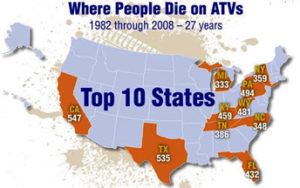After media outlets reported that Jamie Lynn Spears’ 8-year-old daughter was injured while driving an all -terrain vehicle (ATV), many experts warn that children under 16 years of age shouldn’t be allowed to operate adult ATVs. Spears’ daughter, Maddie, was driving the ATV in Louisiana when she fell into a pond. According to an Associated Press report, the Tangipahoa Parish Sheriff’s Office said she was submerged inside the ATV and family members who were nearby couldn’t free her from a seatbelt and the safety netting until an ambulance service arrived and pulled her out. She is currently recovering in the hospital.
According to Colorado Farm Bureau Insurance (CFIB), ATVs are multipurpose vehicles that can weigh up to 600 pounds and reach speeds up to 75 mph.

The U.S. Consumer Product Safety Commission (CPSC) reports that since 1982, more than 5,000 ATV-related deaths have been reported in the United States with those ages 16 or under having one of the highest injury rates. According to Ameriprise, more than 105,000 ATV riders are injured each year, with an estimated 25 percent of all ATV injuries and deaths involving children. The insurer also noted that children ages 16 and under riding adult ATVs are twice as likely to be injured as those riding youth ATVs.
A 2012 report by the American Academy of Pediatrics stated that manufacturer warnings aimed at children under 16 years old are mostly ineffective. The report recommended mandatory helmets and safety courses, as well as licensing to deter ATV use by kids.
“As a pediatrician, my number one job is to keep children safe and healthy. ATVs are not safe for children and should not be used by any child under the age of 16,” said Fernando Stein, MD, FAAP, president of the American Academy of Pediatrics. “Children are not developmentally capable of operating these heavy, complex machines. The American Academy of Pediatrics advises all parents to protect their children by preventing them from driving or riding in an ATV.”
Both the CPSC and AAP recommend not allowing children under 16 to drive adult ATVs under any circumstance.
A press release issued by the Consumer Federation of America a day after Spears’ daughter was reportedly injured on an ATV, noted that nearly 26,700 children were injured and 58 killed in ATV accidents reported in 2015.
“Thousands of families every year suffer as a result of ATV deaths and serious injuries. ATVs are one of the most dangerous products CPSC regulates, causing more deaths and injuries than almost any other product under CPSC’s jurisdiction,” stated Rachel Weintraub, legislative director and general counsel for the Consumer Federation of America. “Data indicates that injuries and deaths from ATVs have increased and much more must be done to prevent these serious and sometimes life altering incidents.”
The press released added that the Consumer Federation of America and the AAP “continue to call upon the agency to reject the manufacture of a transitional, “youth model” ATV for 14- to 16-year-olds that is capable of traveling at speeds up to 38 miles per hour.”
On its website, Foremost Insurance offers several safety tips for those interested in operating ATVs:
- Ask your local dealer about the laws and regulations in your area. Do your best to preserve the areas where you ride, and be sure that you only ride where ATV vehicles are permitted. Read your owner’s manual. Then make sure you take your manual, a small tool kit and essential spare parts with you whenever you ride.
- For optimum protection in case of an accident, always wear a DOT-approved motorcycle helmet, eye protection, a sturdy jacket, long pants, over-the-ankle boots and gloves.
- Find a safe place to practice braking, turning and improving your reaction time to help improve your skills and make you a better – and safer – rider.
- Improve your riding skills by taking a training course. Make sure your ATV is properly licensed or registered. Choose a vehicle that is appropriate for your age and ability.
- Remember that ATV vehicles are meant for operation off pavement and public roads. These surfaces may not only be illegal, but dangerous. Your ATV may be difficult to control on pavement, which could result in an accident.
- Keep your speed right for the conditions and your experience. Be aware of current terrain, visibility and weather conditions, potential hazards or obstacles. Ride only when your senses are sharp. Never do drugs or drink and then ride.
- Be sure to check that your ATV vehicle is running properly before hitting the trail. Always check controls, lights, fuel and oil levels, switches, chain, driveshaft, tires and chassis before you head out. Follow the recommended service schedule for your ATV and be sure an authorized service provider makes all repairs.
- Never carry a passenger on your ATV unless it is designed with an appropriate passenger seat. Additional weight can greatly affect the handling of your ATV and potentially cause loss of control. It’s a good idea to take a buddy along, only on their own vehicle.
The Associated Press contributed to this article.
Was this article valuable?
Here are more articles you may enjoy.

 PE Firm Cornell Sued Over $345 Million Instant Brands Dividend
PE Firm Cornell Sued Over $345 Million Instant Brands Dividend  Chipotle Shareholders Sue Over Fallout From Skimping on Portion Sizes
Chipotle Shareholders Sue Over Fallout From Skimping on Portion Sizes  T-Mobile’s Network Breached as Part of Chinese Hacking Operation
T-Mobile’s Network Breached as Part of Chinese Hacking Operation  Fake Bear Attacks on Car for Fraudulent Insurance Claims Lead to Arrests
Fake Bear Attacks on Car for Fraudulent Insurance Claims Lead to Arrests 